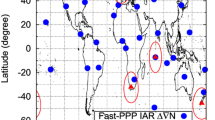Abstract
The main scope of this research is to assess the ultimate accuracy that can be achieved for the slant total electron content (sTEC) estimated from dual-frequency global positioning system (GPS) observations which depends, primarily, on the calibration of the inter-frequency biases (IFB). Two different calibration approaches are analyzed: the so-called satellite-by-satellite one, which involves levelling the carrier-phase to the code-delay GPS observations and then the IFB estimation; and the so-called arc-by-arc one, which avoids the use of code-delay observations but requires the estimation of arc-dependent biases. Two strategies are used for the analysis: the first one compares calibrated sTEC from two co-located GPS receivers that serve to assess the levelling errors; and the second one, assesses the model error using synthetic data free of calibration error, produced with a specially developed technique. The results show that the arc-by-arc calibration technique performs better than the satellite-by-satellite one for mid-latitudes, while the opposite happens for low-latitudes.
Similar content being viewed by others
References
Aragón A, Orús R, Amarillo F, Hernández-Pajares M, Juan JM, Sanz J (2004) Performance of NeQuick ionospheric predictions compared with different ionospheric data. Presented at ESTEC/ESA Navitech’04, Noordwijk
Azpilicueta F, Brunini C, Radicella S (2005) Global ionospheric maps from GPS observations using modip latitude. JASR. doi:10.1016/j.asr.2005.07.069
Bishop G, Walsh D, Daly P, Mazzella A, Holland E (1994) Analysis of the temporal stability of GPS and GLONASS group delay correction terms seen in various sets of ionospheric delay data. In: Proceeding of the ION GPS-94, pp 1653–1661
Brown RG, Hwang PYC (1992) Introduction to random signals and applied Kalman filtering, 2nd edn. Wiley, London
Brunini C, Meza A, Gende M, Azpilicueta F (2007) South American regional ionospheric maps computed by GESA: a pilot service in the framework of SIRGAS. JASR 42: 737–744. doi:10.1016/j.asr.2007.08.041
Ciraolo L, Azpilicueta F, Brunini C, Meza A, Radicela SM (2007) Calibration errors on experimental slant total electron content determined with GPS. J Geod 81(2): 111–120. doi:10.1007/s00190-006-0093-1
Coco DS, Coker C, Dahlke SR, Clynch JR (1991) Variability of GPS satellite differential group delays biases. IEEE Trans Aerosp Electron Syst 27(6): 931–938. doi:10.1109/7.104264
Coïsson P, Radicella SM, Nava B (2007) Use of the NeQuick model for ionospheric scenarios generation. Presented at the IUGG general assembly, Perugia
Conker R, El-Arini MB (1998) A novel approach for an ionospheric obliquity process responsive to azimuthal variation. Presented at the ION-GPS-98, Nashville
Davies K, Hartmann GK (1997) Studying the ionosphere with the global positioning system. Radio Sci 32(4): 1695–1703. doi:10.1029/97RS00451
Dow JM, Neilan RE, Gendt G (2005) The international GPS service (IGS): celebrating the 10th anniversary and looking to the next decade. JASR 36(3): 320–326. doi:10.1016/j.asr.2005.05.125
Goposchkin EM, Coster AJ (1992) GPS L1-L2 bias determination. In: Proceeding international beacon satellite symposium, Massachusetts
Hernandez-Pajares M (2004) IGS ionosphere WG: an overview. In: Proceeding COST 2004, Nice, pp 29–29
Hernández-Pajares M, Juan JM, Sanz J, Colombo O (2002) Improvig the real-time ionopsheric determination from GPS sites at very long distances over the equator. J Geophys Res. doi:10.1029/2001JA009203
Manucci AJ, Iijima BA, Lindqwister UJ, Pi X, Sparks L, Wilson BD (1999) GPS and ionosphere. URSI reviews of radio science, Jet Propulsion Laboratory, Pasadena
Nava B, Coïsson P, Miró Amarante G, Azpilicueta F, Radicella SM (2005) A model assisted ionospheric electron density reconstruction method based on vertical TEC data ingestion. Ann Geophys 48(2): 313–320
Radicella SM, Leitinger R (2001) The evolution of the DGR approach to model electron density profiles. JASR 27(1): 35–40. doi:10.1016/S0273-1177(00)00138-1
Rawer K (ed) (1984) Encyclopedia of physics. Geophysics III, Part VII. Springer, Heidelberg, pp 389–391
Sardon E, Rius A, Zarraoa N (1994) Estimation of the transmitter and receiver differential biases and the ionospheric total electron content from global positioning system observations. Radio Sci 29: 577–586. doi:10.1029/94RS00449
Author information
Authors and Affiliations
Corresponding author
Rights and permissions
About this article
Cite this article
Brunini, C., Azpilicueta, F.J. Accuracy assessment of the GPS-based slant total electron content. J Geod 83, 773–785 (2009). https://doi.org/10.1007/s00190-008-0296-8
Received:
Accepted:
Published:
Issue Date:
DOI: https://doi.org/10.1007/s00190-008-0296-8




